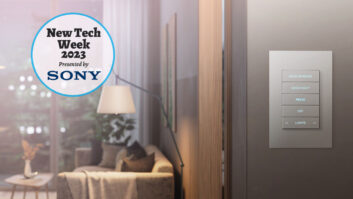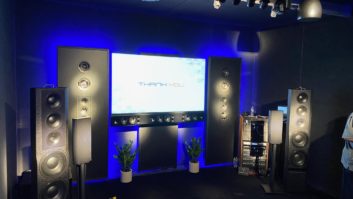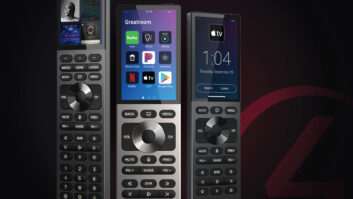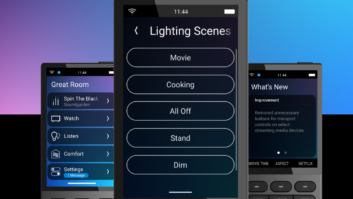Kudos: Siri voice control is great; slick look and nice hand feel; a platform with a future
Concerns: Battery life; waiting on some feature roll-outs
 As installers, we like to focus on the big, “sexy” parts of our installations; the massive 4K screen and projector, the mega-channel-count surround system, the lovingly dressed racks, and so on. But the client likely never touches or physically interacts with — or maybe even sees — any of this stuff. In fact, they’d probably be hard-pressed to even name any of the components they have in their system!
As installers, we like to focus on the big, “sexy” parts of our installations; the massive 4K screen and projector, the mega-channel-count surround system, the lovingly dressed racks, and so on. But the client likely never touches or physically interacts with — or maybe even sees — any of this stuff. In fact, they’d probably be hard-pressed to even name any of the components they have in their system!
The one thing they touch and interact with virtually every day is the control interface. And for many applications, especially TV- and movie-watching, the handheld remote is still king.
For Control4 dealers and system owners it has been a bit of a dry spell when it comes to innovation in the handheld remote lineup. We (still!) have the venerable SR-260 workhorse, but that remote is now over 8 years old, and even when launched it was really just a refresh of the SR-250, which dates back nearly 100 years in electronics’ time. Then there’s the Neeo, which is certainly far cooler-looking and more capable than the 260, but it is already 4 years old at this point and missing key features like voice control. (Also, Neeo is going away…)
Well, I’ve got some good news! You’ll be excited to start adding Control4’s new Halo remotes to your projects. These remotes tick a ton of boxes and lay the foundation for many upgrades to come.
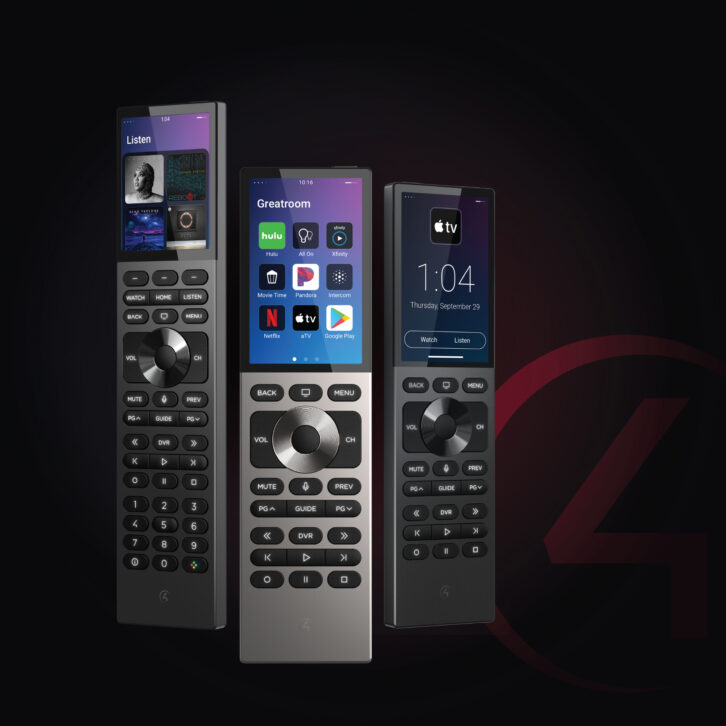
The Halo Family
First displayed at CEDIA Expo 2022, there are two remotes in the Halo family: the Halo and the Halo Touch. The Halo is offered in a black molded plastic case, while the Touch comes in either a black or silver anodized aluminum housing.
While the remotes definitely share cosmetic similarities — especially with the design, feel, and layout of the hard buttons — and are both powered by the same Arm Cortex A7 single-core 720 MHz chip (with Cortex-M4 co-processor), the obvious difference is the physically larger size of the Halo with 0–9 hard buttons and the fully functional touchscreen on the Touch.
The Halo gets a 2.8-inch, full-color, 480 x 640 LCD screen, while the Touch steps up to a 3.2-inch, 480 x 800 touchscreen. Though only .4 inches larger, the Touch’s screen seems bigger, as it takes up a larger percentage of the remote’s overall real estate.
More Reviews: Sony STR-AZ3000ES 9.2-Channel, 8K AV Receiver
Those coming from previous Control4 remotes will notice three specific changes. First, gone is the red C4 button to bring up the on-screen Navigator. (To be fair, Neeo eliminated this as well.) Instead, we have a button with a TV icon at the top nestled between Back and Menu that brings up this GUI. Second is a microphone button for voice control located right below the D-pad. Finally, the front-facing Room Off button is gone, now positioned on the top right of the remote.
Another big change is the network connectivity of Halo. (I can practically hear some of you taking in a giant breath in order to start saying something here. Just wait — I’ll address your concerns.) Both Halos support dual-band Wi-Fi (802.11 a/b/g/n/ac) with dual diversity antennas that are able to frequency hop to detect and adapt to the strongest signal. Where best practices in the past used to be to create a separate 2.4 GHz Wi-Fi SSID reserved for the remotes, that is no longer required. (It is still recommended that the main Control4 processor have a DHCP reservation.)
Also, the Halo is part of Control4’s lower-priced, single-room CORE lite bundle, meaning you’ll likely be selling it sooner than later!
Addressing the Elephant
If you‘ve visited any of the Control4 dealer forums, you’ve probably read some heated comments about Halos losing connectivity, searching for the network, and generally poor performance across projects.
So, I’m going to preface this by saying I can only describe my experience with the Halo and Touch, and I never had a single connectivity issue. Every time I picked up the remote, it woke up, was on the network, and ready to go. For the record, I have a Luxul Epic Mesh system with four total nodes, and I connected the remotes to my 5 GHz network. (The only time I experienced a “searching” or “network error” moment was after I had to reboot the closest Wi-Fi node in my Luxul mesh network and after rebooting my EA5 controller following an update. But as soon as the node and controller came back online, the remotes reconnected and resumed normal operation.)
I’ll also say I did experience a lot of connectivity issues with the Neeo. Either coming out of “sleep” or just sitting there hitting channel up, channel up, channel up, and then the Neeo would suddenly drop off and lose connection for like 30–45 seconds. Frustrating as hell. Because of that, my company never sold a single Neeo.
Also, I didn’t get a day-one Halo. I think I received my review samples a couple of months after release, so certainly enough time for Control4 to address some of these early connectivity issues with firmware updates.
However, I felt it fair to give Control4 a chance to comment on this, and this is what Eric Fritz, Snap One’s director of product management, had to say:
“When we launched Halo earlier this year, we brought it to market with an updated Wi-Fi stack that included 2.4 and 5 GHz band support, as well as dual diversity antennas. This gives us and our Partners flexibility in range, throughput, and the ability to move/access point hop depending on environment and network configuration. While we do extensive testing throughout development, there were still some Partners who experienced network errors at launch. Most of these issues could be resolved through network configuration recommendations.
“That said, I’m proud of how quickly our development team was able to diagnose, test, and write fixes for these network error cases so that configuration recommendations wouldn’t be as needed going forward. Our OTA update architecture meant that we were able to introduce meaningful stability improvements roughly a month after the remote began shipping. These monthly OTA updates have continued and next month customers will see another large Wi-Fi improvement that comes with significant battery life advantages as well.”
Setup

In order to add a Halo, the system needs to be running at least OS 3.3.2. Similar to the Neeo, Halo is designed for an end-user to easily add it to their system without requiring a programmer or opening Composer. When the remote is powered on for the first time, a QR code appears on the remote’s screen that is scanned in with the customer’s device using the Control4 mobile app. (You go to settings, select the system, and then click “Add Halo Remote.”) After scanning the code, it walks you through connecting to the Wi-Fi network and which room to add the remote to in the project.
If you don’t have access to the client’s device, installers can also add a Halo to the system without using the mobile app.
From this point, the remote is running and ready to go, but getting the most out of it — and using the new voice features — requires a bit of programming.
Currently the Halos support AppleTV Siri and Xfinity voice control, but Control4 says the voice engine built into the remote is very scalable and easy to integrate with third-party devices, and they have plans to work with many other services, including Alexa, Google, and expanding the HomeKit integration to allow full home control outside of AppleTV, as well as voice control with Dish, DirecTV, and Roku. They said the remote is merely capturing a .WAV file and directing it to the appropriate service, which takes a very small amount of processing.
Xfinity isn’t available where I live, but I do have an AppleTV, which was already working with my Control4 system. Using voice control requires installing the latest Voice Coordinator (v111+) agent, along with the latest AppleBridge.c4z (v53+) and AppleTV.c4z (v50+) drivers. You also need to ensure that Siri is enabled within the AppleTV. (Control recommends using a wired network connection to the AppleTV, as well as giving it a DHCP reservation and disabling the sleep feature for best operation.) After you’ve done that, refresh navigators and then voice should be good to go!
Similar to the Neeo, if you favorite something to a room, it will appear in the Touch’s display. This works great for any of the custom button programming you’ve created; however, this doesn’t currently include everything such as shading control or security. (Control4 says the full custom-button agent will be released in the next firmware update, and that shade control will be the next big feature added to the remotes.)
Remember those three custom button dots on the SR-260’s? If you ever used them at all, it was probably pretty limited. But Halo totally ups the usability of these with a powerful new ability to program and re-label these as dynamic custom buttons. With a bit of creative programming, using a combination of macros, variables, and a timer, you can turn these three buttons into nine actions, with the button labels and commands customized per room, per activity, based on time of day, etc.
So, as an example, I have the button labels on my Halo change based on the room selected, giving me instant access to commands I use frequently in that room. In my family room, the buttons initially say, “Family,” “Kitchen,” and “Fan”; in my Projector room they change to “Aspect,” “Screen,” and “Lights”; and in my bathroom they say “Female,” “Pop,” and “Jazz.” Pressing the “Family” button re-labels all of the buttons to say “Raise,” “Lower,” and “Toggle,” while pressing “Aspect” re-labels them to “16×9,” “2.0,” and “2.40,” and “Female” re-labels them to “Fiona,” “Taylor,” and “Sigrid.”
Hat tip to Control4 Facebook users Andrew Chapman, Eddy Trochez, and Jacop Whipple for help in figuring out how to do this. There is also a walk-thru in the Halo’s driver documentation.
This dynamic button programming is also pretty crucial for the Halo right now as it doesn’t currently have access to any of the other custom button programming in the project. (Though this is coming in the next update.)
If you’ve ever misplaced a remote, you’ll appreciate that you can make the remotes play a beep. With a simple custom button added to the mobile app or touchscreen, you can hit “Find Halo” or “Find Touch” and it will start beeping, helping you track it down.
Performance
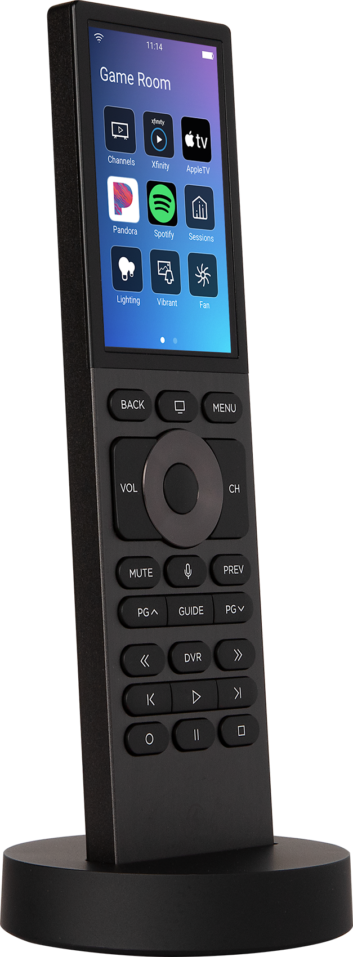
As mentioned, a remote is among the most personal devices you’ll install in a client’s home, and something they will likely touch multiple times a day. Thus the “hand feel” and ergonomics are of utmost importance, and I think the Halos have nailed this. They feel solid, yet well balanced and comfortable in the hand. I always found the Neeo just a tad thin and light, but the Halos have the right amount of thickness and weight to just fit better.
The front of the Touch feels a shade more luxe with its premium anodized aluminum housing, but this is no knock against the Halo. Also, due to its shorter length, the D-pad of the Touch perfectly lands under your thumb when you pick it up.
Which remote someone prefers will likely depend on how they use their system, and which remote they are coming from. Since I previously used the SR-260 as my primary system control — and I still use my Dish Hopper to watch a majority of my programming — I felt most comfortable with the Halo. I loved its balance and hand feel, and really liked channel browsing with the Halo’s full 0–9 hard keys. I also really liked the new dynamic button programming of the three custom keys, giving me quicker access to things I use frequently. (Similar to Neeo, the Touch supports the Channels feature, which lets you browse and tune to favorite channels by icon, but I just never got into the habit of using my system that way.)
However, when Control4 rolls out the full suite of updates — namely shading, whole-house lighting, and security integration — the tide will likely shift toward the Touch being my preferred wand for whole-house control, while the Halo will make a terrific single-room option.
Another change is the top-mounted Off button, which I didn’t have any issue with. Merely tell users that’s where it is, and they shouldn’t have a problem. I think putting it there keeps the front screen area clean, and also virtually eliminates any accidental off incidents. (I can’t tell you how often the Off button has been accidentally pressed or sat on with my 260…) I do like that you can turn the “Room Off Confirmation” off, so the remote doesn’t ask if you really want to turn the room off. Chances are in the high-90s percent that if this button is pressed, you want the room off.
If you aren’t in an activity that supports voice control (currently limited to AppleTV and Xfinity), pressing the mic button will produce a screen that says, “To utilize the microphone button, launch one of the devices below,” letting you jump right into that service. If you press the mic button in a room with no available devices, it says, “Watch this space! There is currently no voice device configured for this room. Please switch to a room where there is a voice-capable device, or contact your integrator for voice integration.”
Now, I wouldn’t say that having voice control with the AppleTV was a game-changer, but it was definitely awesome, and once you start using it, it is tough to go back. Not only is it far quicker to jump from app to app, searching is so much easier. Being able to just open select the AppleTV activity and then press/hold the voice button and say, “Play Ahsoka on Disney” or “Show me pickleball videos on YouTube” was great. You also get those cool Apple touches, such as asking, “What did they say?” will rewind what you’re watching 10 seconds and temporarily turn on subtitles, or asking “Who stars in this?” to see a cast list.
I did have a couple of instances with the Touch where I pressed the mic button while using AppleTV and I’d get the “To utilize the microphone button, launch one of the devices below” prompt. From there, the only way I could get the mic to work again was to restart the remote (holding the Off button for about 10 seconds).
Like the Neeo, both remotes dock/charge standing up, and both can use the same dock. While the Halo has a slightly larger battery (2000 mAH Li-Ion versus the Touch’s 1900 mAH), I didn’t notice any appreciable difference in lifespan.
In fact, battery life is the one thing I really didn’t love about the Halos, as I was lucky to get around 24 hours out of the remotes off dock. My typical use case is to remove the remote from the dock in the evening, use it to watch TV until I go to bed, and then set it on the couch until I am ready to use it again the next day. With the SR-260’s rechargeable battery and miserly energy usage, we might get two weeks of use out of it in this manner, but the Halos are almost always borderline dead the next evening.
Control4 suggested I lower the remotes’ deep sleep setting from the default 90 minutes to 30 minutes, which seemed to help a bit. They also said that if the Wi-Fi network has a multicast enhancement feature that does a persistent wake connection to devices, to turn this off. (This was not a setting offered on my Luxul nodes.) Further, they said that a firmware release coming next month is expected to double the battery life in most use cases. In the meantime, its best to leave the Halo on the dock and not on the couch.
Another minor nit was the remotes’ pick-up/wake sensitivity. I have a pretty powerful subwoofer system in my home theater, and this often made the remotes “wake” during bass-heavy scenes. Not only does this keep the remote from going into “deep sleep,” the sudden light from the screen is a bit distracting. Currently there’s no way to adjust this, but Control4 says they are looking at giving users a sensitivity slider in a coming release.
Having lived with Neeo since launch, I’m familiar with how Control4 continually rolls out new features, updates, and improvements, and it sounds like there is a robust plan to expand Halo. Beyond filling out the lighting and shading, they are planning on delivering advanced security features that will include intercom with Chime doorbell integration. This will send a push notification to the remote along with a screen grab from the Chime, and then allow using the microphone as a push-to-talk feature with the Chime.
Similar to the “blue dot” updates in the Neeo, as new features are delivered, the remote will present the user with “cards” spelling out the benefits of the new features.
While the venerable SR-260 has served us well (and will continue in the lineup), the Halo definitely paves Control4’s way to the future. And as they continue developing it and rolling out features, it will only get better!
888-400-4070; CONTROL4.COM
Product Specs:
- Requires control system running OS 3.3.2+
- Supports Wi-Fi 802.11 a/b/g/n/ac 2.4 or 5GHz, with dual diversity antennas
- Near field microphone with voice support for Xfinity and AppleTV
- Arm Cortex A7 single core processor at 720MHz with Cortex-M4 coprocessor
- Full color LCD screen; Halo: 2.8-inch diagonal 480 x 640 resolution; Touch: 3.2-inch diagonal 480 x 800
- Includes docking/charging station

